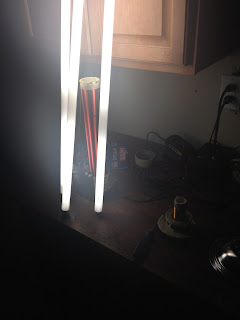3. Slayer Exciter V2
< Intro >
After building my first Tesla coil with a slayer exciter circuit, I wondered if I can try to make a bigger version of the tesla coil, just to see if the output coming off would be larger than the previous one. And so I have set up with the same circuit as in my previous tesla coil, but with components that can handle more power, as well as having a larger primary and secondary coil. As a result, this second Tesla coil was indeed more powerful than my previous, smaller Tesla coil.
<Operation/how it works>
I have already covered how the slayer exciter works in a nutshell, but in short, it uses a transistor to make oscillations based on the switching every time the current flows in the base, and as the transistor is on, so does the current flow through the primary coil. This in turn brings up the voltage as the primary coil magnetizes the secondary coil, and with the parasitic capacitor in the upload, they resonate/coupled with one another, generating high voltages in a higher frequency.
For the changes, I made it use a 24-volt power supply instead of the 5-volt power supply, I then also changed the silicon transistor for a power transistor (TIP3055) so that it can sustain a higher current,
and bring the high voltage to the output. After the changes, the Tesla coil emits 1-inch sparks, lights up long fluorescent tubes, and powers up the RF receiver. The sparks are powerful to the point that you can light up a paper on fire just by arcing the Tesla coil more easily.
 |
| <Test with 3 tubes> |
Another change is that since the transistor is being powered by a 24-volt source, a big heatsink is needed to cool it off, otherwise, it can burn out/explode from all this power. The coils for this project were much bigger in terms of diameter and length, with the biggest having to be for the secondary coil. It is much taller than the previous one with around 1500 turns for the secondary coil. Having a larger secondary with the number of turns like that increases the inductance within in secondary coil, thus allowing a higher output. However, since this is also like a transformer, it's important to get the ratio right for both the primary and secondary coil, otherwise, the output will be lowered as they cant resonate with each other correctly.
 |
| <Spark test> |
While testing out my new tesla coil, I decided to test out its wireless capabilities, and because the tesla coil is tall, I wonder if the output power is powerful enough to power things such as an led at a distance. Physically, it even looks like an antenna that can transmit power at all angles. Below are the 2 videos - (and the circuit diagram), where one shows the results of the tesla coil transmitting power to the reciever, and the other shows how it can power all these fluorescent tubes. The receiver itself is nothing more than a "reverse" tesla coil, being that it collects all that high voltage, and steps it down to increase the amps while lowering the voltage down, it's then fed to a lamp circuit that has the rectifier installed, and the LEDs.
It's a neat project to build, and a great way to experiment with wireless energy. Just know the risks, and you'll be fine operating it.



Comments